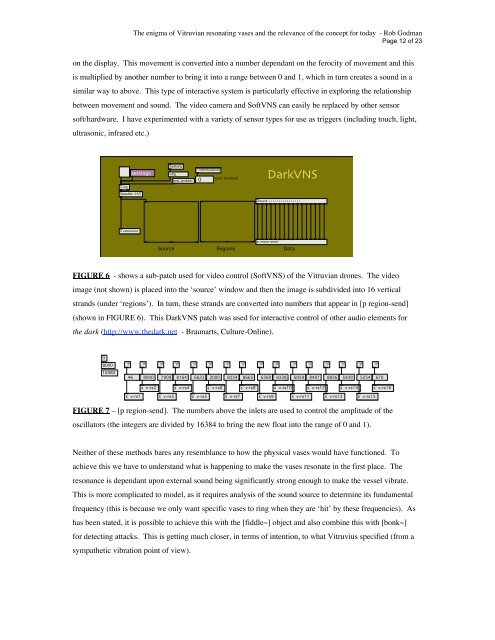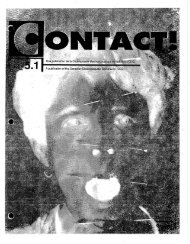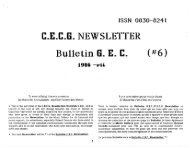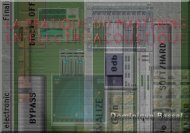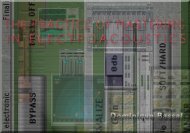The enigma of Vitruvian resonating vases and the relevance ... - CEC
The enigma of Vitruvian resonating vases and the relevance ... - CEC
The enigma of Vitruvian resonating vases and the relevance ... - CEC
Create successful ePaper yourself
Turn your PDF publications into a flip-book with our unique Google optimized e-Paper software.
<strong>The</strong> <strong>enigma</strong> <strong>of</strong> <strong>Vitruvian</strong> <strong>resonating</strong> <strong>vases</strong> <strong>and</strong> <strong>the</strong> <strong>relevance</strong> <strong>of</strong> <strong>the</strong> concept for today - Rob Godman<br />
Page 12 <strong>of</strong> 23<br />
on <strong>the</strong> display. This movement is converted into a number dependant on <strong>the</strong> ferocity <strong>of</strong> movement <strong>and</strong> this<br />
is multiplied by ano<strong>the</strong>r number to bring it into a range between 0 <strong>and</strong> 1, which in turn creates a sound in a<br />
similar way to above. This type <strong>of</strong> interactive system is particularly effective in exploring <strong>the</strong> relationship<br />
between movement <strong>and</strong> sound. <strong>The</strong> video camera <strong>and</strong> S<strong>of</strong>tVNS can easily be replaced by o<strong>the</strong>r sensor<br />
s<strong>of</strong>t/hardware. I have experimented with a variety <strong>of</strong> sensor types for use as triggers (including touch, light,<br />
ultrasonic, infrared etc.)<br />
v.dig<br />
speedlim 250<br />
s videoinput<br />
Source<br />
loadbang<br />
settings vdig<br />
seq_grabber<br />
r VNSthreshold<br />
0<br />
noise threshold<br />
Regions<br />
unpack i i i i i i i i i i i i i i i i<br />
p region-send<br />
DarkVNS<br />
FIGURE 6 - shows a sub-patch used for video control (S<strong>of</strong>tVNS) <strong>of</strong> <strong>the</strong> <strong>Vitruvian</strong> drones. <strong>The</strong> video<br />
image (not shown) is placed into <strong>the</strong> ‘source’ window <strong>and</strong> <strong>the</strong>n <strong>the</strong> image is subdivided into 16 vertical<br />
str<strong>and</strong>s (under ‘regions’). In turn, <strong>the</strong>se str<strong>and</strong>s are converted into numbers that appear in [p region-send]<br />
(shown in FIGURE 6). This DarkVNS patch was used for interactive control <strong>of</strong> o<strong>the</strong>r audio elements for<br />
<strong>the</strong> dark (http://www.<strong>the</strong>dark.net - Braunarts, Culture-Online).<br />
0<br />
8000<br />
16383<br />
46<br />
s v-rs1<br />
8000 7909 8164 6623 3000 8254 8665 6369 8338 6059 8497 8836 5939 5254 670<br />
s v-rs2<br />
s v-rs3<br />
s v-rs4<br />
s v-rs5<br />
s v-rs6<br />
s v-rs7<br />
s v-rs8<br />
s v-rs9<br />
Data<br />
s v-rs10<br />
s v-rs11<br />
s v-rs12<br />
s v-rs13<br />
s v-rs14<br />
s v-rs15<br />
s v-rs16<br />
FIGURE 7 – [p region-send]. <strong>The</strong> numbers above <strong>the</strong> inlets are used to control <strong>the</strong> amplitude <strong>of</strong> <strong>the</strong><br />
oscillators (<strong>the</strong> integers are divided by 16384 to bring <strong>the</strong> new float into <strong>the</strong> range <strong>of</strong> 0 <strong>and</strong> 1).<br />
Nei<strong>the</strong>r <strong>of</strong> <strong>the</strong>se methods bares any resemblance to how <strong>the</strong> physical <strong>vases</strong> would have functioned. To<br />
achieve this we have to underst<strong>and</strong> what is happening to make <strong>the</strong> <strong>vases</strong> resonate in <strong>the</strong> first place. <strong>The</strong><br />
resonance is dependant upon external sound being significantly strong enough to make <strong>the</strong> vessel vibrate.<br />
This is more complicated to model, as it requires analysis <strong>of</strong> <strong>the</strong> sound source to determine its fundamental<br />
frequency (this is because we only want specific <strong>vases</strong> to ring when <strong>the</strong>y are ‘hit’ by <strong>the</strong>se frequencies). As<br />
has been stated, it is possible to achieve this with <strong>the</strong> [fiddle~] object <strong>and</strong> also combine this with [bonk~]<br />
for detecting attacks. This is getting much closer, in terms <strong>of</strong> intention, to what Vitruvius specified (from a<br />
sympa<strong>the</strong>tic vibration point <strong>of</strong> view).


